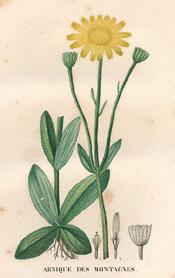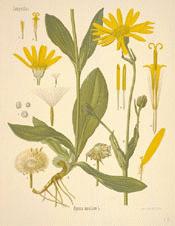
Botanical.com Home Page
ArnicaBotanical: Arnica montana (LINN.)
---Synonyms---Mountain Tobacco. Leopard's Bane.
|

|
(arnica montana) Click on graphic for larger image |
---Cultivation---Arnica thrives in a mixture of loam, peat, and sand. It may be propagated by root division or from seed. Divide in spring. Sow in early spring in a cold frame, and plant out in May.
The flowers are collected entire and dried, but the receptacles are sometimes removed as they are liable to be attacked by insects.
The root is collected in autumn after the leaves have died down.
---Constituents---A bitter yellow crystalline principle, Arnicin, and a volatile oil. Tannin and phulin are also present. The flowers are said to contain more Arnicin than the rhizome, but no tannin.
---Medicinal Action and Uses---In countries where Arnica is indigenous, it has long been a popular remedy. In the North American colonies the flowers are used in preference to the rhizome. They have a discutient property. The tincture is used for external application to sprains, bruises, and wounds, and as a paint for chilblains when the skin is unbroken. Repeated applications may produce severe inflammation. It is seldom used internally, because of its irritant effect on the stomach. Its action is stimulant and diuretic, and it is chiefly used in low fevers and paralytie affections.
Arnica flowers are sometimes adulterated with other composite flowers, especially Calendula officinalis, Inula brittanica, Kragapogon pratensis, and Scorzonera humilis.
A homoeopathic tincture, X6, has been used successfully in the treatment of epilepsy; also for seasickness, 3 X before sailing, and every hour on board till comfortable.
For tender feet a foot-bath of hot water containing 1/2 oz. of the tineture has brought great relief. Applied to the scalp it will make the hair grow.
Great care must be exercised though, as some people are particularly sensitive to the plant and many severe cases of poisoning have resulted from its use, especially if taken internally.
British Pharmacopoeia Tincture, root, 10 to 30 drops. United States Pharmacopoeia Tincture, flowers, 10 to 30 drops.
[Top]
|
Purchase from Richters Seeds
American Arnica (Arnica chamissonis) Seeds European Arnica (Arnica montana) Seeds American Arnica (Arnica chamissonis) Plants European Arnica (Arnica montana) Plants |
© Copyright Protected 1995-2025 Botanical.com
